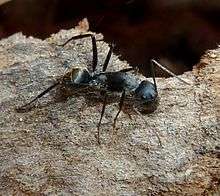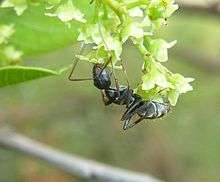Camponotus cinctellus
Camponotus cinctellus, commonly known as the shiny sugar ant, is a species of sugar ant[2] with an extensive range in the eastern Afrotropics.
| Shiny sugar ant | |
|---|---|
 | |
| Scientific classification | |
| Kingdom: | |
| Phylum: | |
| Class: | |
| Order: | |
| Family: | |
| Genus: | |
| Species: | C. cinctellus |
| Binomial name | |
| Camponotus cinctellus (Gerstaecker, 1859)[1] | |
| Synonyms | |
| |
Description
The somewhat shimmering, golden-hued pubescence of the gaster is characteristic of all the worker castes.[3] On the gaster, erect bristles are limited to the posterior segments. The reddish leg colour distinguishes it from the similar but smaller C. sericeus.
Range

Feeding on nectar
It is native to eastern Africa from Eritrea to Kenya, Rwanda, the DRC, Tanzania, Mozambique, Zimbabwe and South Africa, as far south as coastal Transkei.[4]
Subspecies
Two subspecies are recognized:[5]
- C. c. cinctellus – type locality in Mozambique
- C. c. belliceps Santschi, 1939 – type locality in the DRC
gollark: Specifically, the crawler and a tiny bit of page rendering code for my bad search engine.
gollark: Too late! I've written 200 lines of JS and I probably won't rewrite it!
gollark: That's pretty great too.
gollark: The PotatOS Random Stuff API uses Python/Flask, most of my stuff uses Node/Express.
gollark: I honestly prefer Node/Express to Python/Flask/whatever.
References
- (2001) , website, Hymenoptera Name Server
- ITIS: The Integrated Taxonomic Information System. Orrell T. (custodian), 2011-04-26
- Slingsby, Peter. "FORMICINAE: the Sugar or Pugnacious ants". Ant Catalogue: Southern Africa. Retrieved 19 April 2016.
- "Camponotus cinctellus". Antweb. Retrieved 11 June 2015.
- Bisby F.A.; Roskov Y.R.; Orrell T.M.; Nicolson D.; Paglinawan L.E.; Bailly N.; Kirk P.M.; Bourgoin T.; Baillargeon G.; Ouvrard D. (red.) (2011). "Species 2000 & ITIS Catalogue of Life: 2011 Annual Checklist". Species 2000: Reading, UK. Retrieved 24 September 2012.
This article is issued from Wikipedia. The text is licensed under Creative Commons - Attribution - Sharealike. Additional terms may apply for the media files.